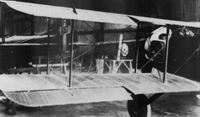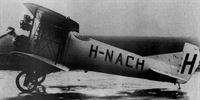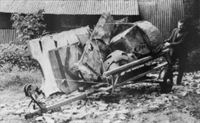
Описание
Страна : Великобритания
Год : 1917
Одноместный истребитель
ВАТ F.K.22 и F.K.23 Bantam
В 1917 году Фредерик Колховен покинул компанию "Armstrong Whitworth", он поступил в "British Aerial Transport Co. Ltd" (BAT). Первой разработкой на новом месте стал ВАТ F.K.22 Bantam, одноместный истребитель. На двухсекционном биплане деревянной конструкции с полумонококовым фюзеляжем устанавливался звездообразный двигатель ABC Mosquito мощностью 120 л.с. Построенный компанией в инициативном порядке, прототип поднялся в воздух в сентябре 1917 года. Характеристики оказались достаточно обнадеживающими для размещения заказа на шесть опытных машин. Но проблемы с двигателем привели к его замене на более мощный ABC Wasp I мощностью 170 л.с. - этот двигатель установили на первом и третьем опытных самолетах, получивших обозначение F.K.22/1. Вторая машина летала с ротативным Gnome Monosoupape мощностью 100 л.с, а позже - с ротативным Le Rhone 9J мощностью 110 л.с; самолет получил обозначение F.K.22/2 Bantam Mk II. Именно он стал первым из полетевших опытных самолетов, на его основе стала осуществляться разработка новых типов машин, оценочные испытания проводились в Мартлешем-Хит в январе 1918 года.
Остальные три самолета, заказанные по первичному контракту, обозначались как F.K.23 Bantam Mk I. Прототип Bantam Mk I сохранил деревянную конструкцию, но был меньшего размера: размах крыла уменьшили до 7,62 м, а длину с 6,30 м до 5,61 м. Для Mk I выбрали двигатель Wasp, летные испытания начались в мае 1918 года, были построены и еще два прототипа - несколько большего размера и модифицированной конструкции, после чего выпустили еще девять самолетов из дополнительного заказа на 12 предсерийных машин. Первый из них поднялся в воздух в Королевском НИИ авиации в Фарнборо 26 июля 1918 года. Два самолета отправили для оценки за границу: один в Виллакубле (Франция), другой в Райт-Филд (США). Последний получил американское обозначение Р. 167 и в конечном итоге был поставлен на хранение 30 сентября 1922 года.
В предсерийных самолетах Bantam реализовали множество изменений, в основном направленных на преодоление неудовлетворительных характеристик, приводивших к входу в штопор прототипов. Размах крыла увеличили, установили хвостовой стабилизатор большего размера, переделали и вертикальное хвостовое оперение: уменьшили киль и увеличили руль направления. Продолжавшиеся проблемы с двигателями и сокращение британских ВВС повлияли на будущее Bantam. Была предпринята попытка заменить двигатель - на последнем серийном экземпляре стоял Wasp II мощностью 200 л. с. После ликвидации компании ВАТ Колховен купил этот самолет и перевез его в Нидерланды, где заменил двигатель на звездообразный Armstrong Siddeley Lynx мощностью 200 л.с. Позднее несколько Bantam появилось в британском гражданском регистре, в том числе один гоночный, на котором 21 июня 1919 года в Хендоне (пригород Лондона) совершил полет летчик-испытатель ВАТ майор Кристофер Дрейпер. Самолет отличался тем, что нижнее крыло имело половину размаха, а верхнее удерживалось раскосами.
ВАРИАНТ
F.K.27: построен в 1919 году, находился в воздухе один раз во время испытательного полета. Разработка гражданского гоночного и аэробатического самолета из серии Bantam с полутароплановой коробкой крыла и экипажем из двух человек, сидевших рядом. Имел звездообразный двигатель ABC Wasp II мощностью 200 л.с. (149 кВт), максимальную скорость 229 км/ч, начальную скороподъемность 762 м/мин, размах крыла 7,92 м, длину 6.27 м, высоту 2.39 м и площадь крыльев 18,58 м'
ТАКТИКО-ТЕХНИЧЕСКИЕ ХАРАКТЕРИСТИКИ
ВАТ F.K.23 Bantam Mk 1
Тип: одноместный истребитель
Силовая установка: звездообразный двигатель ABC Wasp I мощностью 170л.с (127 кВт)
Характеристики: макс, скорость на высоте 1980 м - 206 км/ч; начальная скороподъемность 381 м/мин; набор высоты 1980 м - 5 мин 10 с; практический потолок 6100 м; дальность полета 402 км; продолжительность полета 2 ч 30 мин
Масса: пустого 378 кг; максимальная взлетная 599 кг
Размеры: размах крыла 7,62 м; длина 5,61 м; высота 2,06 м; площадь крыльев 17,19м'
Вооружение: два неподвижных 7,7-мм пулемета Vickers для стрельбы вперед
Описание:
- ВАТ F.K.22 и F.K.23 Bantam
- Flight, July 1920
The Olympia Aero Show 1920
Фотографии
-
Мировая Авиация 43
Регистрационный номер: F1657 [6], G-EAFN [6], K-155 [6] F.K.23 Bantam Mk I под номером "5" показан в гоночной конфигурации. Позднее самолет получил гражданский регистрационный номер G-EAFN.
-
Aeroplane Monthly 1983-03 / A.Jackson - Bats and Bantams (1)
The first F.K.22 at Hendon in 1917 with cowled-in Mosquito engine and Peter Legh’s Warren helmet on the wing.
-
Aeroplane Monthly 1983-03 / A.Jackson - Bats and Bantams (1)
The F.K.22 with spinner and open-ended cowling to improve cooling
-
Aeroplane Monthly 1983-03 / A.Jackson - Bats and Bantams (1)
Регистрационный номер: B9944 Three ‘large’ Bantams, all with brand new cowlings, at Hendon on June 16, 1919. These are the only known likenessess of B9944, the second F.K.22/2 and fourth F.K.22/1
-
Aeroplane Monthly 1983-03 / A.Jackson - Bats and Bantams (1)
Регистрационный номер: B9945 [3] The Gnome-engined F.K.22/2 B9945 after roll-out at Hendon in January 1918.
-
Aeroplane Monthly 1983-03 / A.Jackson - Bats and Bantams (1)
Регистрационный номер: B9945 [3] The same aircraft seen at Martlesham Heath during trials in February 1918
-
Aeroplane Monthly 1983-03 / A.Jackson - Bats and Bantams (1)
Регистрационный номер: B9945 [3] B9945 at CFS with a 110 h.p. Le Rhone and showing the blanked off cowling louvre.
-
Aeroplane Monthly 1983-03 / A.Jackson - Bats and Bantams (1)
Регистрационный номер: B9947 [3] The ‘small’ F.K.22/1 machine B9947 trestled up at Hendon, probably for fuselage repairs, in February 1918
-
Мировая Авиация 43
Регистрационный номер: B9947 [3] F.K.22 Bantam Mk II (на фотографии), в целом похожий на F.K.23 Bantam Mk I, был несколько больше. Голова пилота выглядывала из выреза в верхнем крыле.
B9947 awaiting a new engine at Hendon in February 1918. -
Aeroplane Monthly 1983-03 / A.Jackson - Bats and Bantams (1)
Регистрационный номер: B9947 [3] Rear view of the same aircraft showing the one-piece wing and prominent plywood joints over longerons and frames.
-
Aeroplane Monthly 1983-04 / A.Jackson - Bats and Bantams (2)
Регистрационный номер: F1653 [3] The first production Bantam, F1653, with new wings and ailerons, at Farnborough in August 1918.
-
Aeroplane Monthly 1983-04 / A.Jackson - Bats and Bantams (2)
Регистрационный номер: F1653 [3] The first production Bantam, F1653, with pointed engine cowlings, November 1918.
-
Aeroplane Monthly 1983-04 / A.Jackson - Bats and Bantams (2)
Регистрационный номер: F1653 [3] F1653 in a pale blue paint scheme, lined up for the Headquarters Race at the 1921 RAF Pageant at Hendon.
-
Aeroplane Monthly 1983-04 / A.Jackson - Bats and Bantams (2)
Регистрационный номер: F1654 [11], G-EACN [11], K-123 [11] The second F.K.23 Bantam, F1654, at Martlesham in September 1918.
-
Flight 1920-07 / Flight
Регистрационный номер: F1655 [4] -
Aeroplane Monthly 1983-03 / A.Jackson - Bats and Bantams (1)
Регистрационный номер: F1655 [4] The Villacoublay Bantam F1655 in March 1919
The little Bat "Bantam" which follows was designed by Frederick Koolhoven, and was used until comparatively recently for scientific tests of spinning. -
Aeroplane Monthly 1983-04 / A.Jackson - Bats and Bantams (2)
Регистрационный номер: F1655 [4] Bantam F1655 at Villacoublay in October 1918, with fuselage number 12B-114.
-
Aeroplane Monthly 1983-04 / A.Jackson - Bats and Bantams (2)
Регистрационный номер: F1656 Bantam F1656 at Farnborough in December 1918.
-
Aeroplane Monthly 1983-04 / A.Jackson - Bats and Bantams (2)
Регистрационный номер: F1657 [6], G-EAFN [6], K-155 [6] A unique picture showing Bantam F1657 in the works in December 1918 with the previous machine (foreground) and an F.K.24 Baboon behind.
Другие самолёты на фотографии: BAT FK-24 Baboon - Великобритания - 1918
-
Flight 1920-07 / Flight
Регистрационный номер: F1661 [3], H-NACH [3] -
Aeroplane Monthly 1983-06 / A.Jackson - Bats and Bantams (4)
Регистрационный номер: F1661 [3], H-NACH [3] The Wasp II Bantam F1661 at Martlesham Heath in December 1919.
-
Aeroplane Monthly 1983-04 / A.Jackson - Bats and Bantams (2)
The unmarked F.K.23 Bantam, with abnormal ailerons, at Martlesham in April 1918.
-
Aeroplane Monthly 1983-04 / A.Jackson - Bats and Bantams (2)
Регистрационный номер: F1655 [4] Peter Legh taking off from Villacoublay in F1655 with his Warren helmet protruding through the “hole”.
-
Aeroplane Monthly 1983-04 / A.Jackson - Bats and Bantams (2)
Регистрационный номер: F1657 [6], G-EAFN [6], K-155 [6] Cyril Turner flying low past the London Flying Club's headquarters in the “little" BAT, F1657, at Hendon on June 9, 1919.
-
Aeroplane Monthly 1990-03 / Personal album. Civil
Регистрационный номер: K-155 [6], F1657 [6], G-EAFN [6] In the foreground is BAT F.K.23 Bantam K-155, later G-EAFN, carrying the racing number 5. This and other Bantams were raced at Hendon weekends during 1919, Cyril Turner invariably flying K-155, which was owned by the British Aerial Transport Company Ltd. K-155's registration was allowed to lapse in June 1920. The engine was a 170h.p. ABC Wasp. Behind K-155 may he seen another Bantam, this time a Grahame-White G.W.E.6A Bantam, registered K-153, later G-EAFL. The 20ft span biplane was powered by an 80 h.p. le Rhone rotary.
Другие самолёты на фотографии: Grahame-White Bantam - Великобритания - 1919
-
Aeroplane Monthly 1983-05 / A.Jackson - Bats and Bantams (3)
Регистрационный номер: F1657 [6], G-EAFN [6], K-155 [6] The “little BAT" racing as No. 5 at Hendon on June 7, 1919.
-
Aeroplane Monthly 1983-05 / A.Jackson - Bats and Bantams (3)
Регистрационный номер: F1654 [11], G-EACN [11], K-123 [11] Charles Nungesser climbing into the first white civil Bantam, not yet marked K-123, at Hendon on June 16, 1919.
-
Aeroplane Monthly 1983-05 / A.Jackson - Bats and Bantams (3)
Регистрационный номер: K-123 [11], F1654 [11], G-EACN [11] K-123 outside BAT's sheds (off picture left) showing the two wide fuselage bands.
-
Air Enthusiast 1996-07 / A.Robertson - In from the Cold. Avro 504L Seaplane G-EASD
Регистрационный номер: K-123 [11], F1654 [11], G-EACN [11] The oldest extant UK registered aircraft is the BAT FK-23 Bantam G-EACN, registered on May 29, 1919. It is seen here with temporary markings K-123. The remains, once part of the Shuttleworth collection are now under restoration in Amsterdam.
-
Aeroplane Monthly 1983-05 / A.Jackson - Bats and Bantams (3)
Регистрационный номер: K-123 [11], F1654 [11], G-EACN [11] Robin Duke with Bantam K-123 at ELTA.
-
Aeroplane Monthly 1983-06 / A.Jackson - Bats and Bantams (4)
Регистрационный номер: K-123 [11], F1654 [11], G-EACN [11] C.P.B. Ogilvie with Bantam K-123 at Hendon in 1921.
-
Aeroplane Monthly 1983-05 / A.Jackson - Bats and Bantams (3)
Регистрационный номер: K-123 [11], F1654 [11], G-EACN [11] Bantam K-123 on the Aerial Derby starting line at Hendon on June 21, 1919.
-
Aeroplane Monthly 1991-04 / M.Oakey - Grapevine
Регистрационный номер: K-123 [11], F1654 [11], G-EACN [11] A 1919 photograph of BAT Bantam K-123; its remains have been stored for many years by the Shuttleworth Collection, but are soon to go to Holland for restoration to flying condition.
-
Aeroplane Monthly 1983-05 / A.Jackson - Bats and Bantams (3)
Регистрационный номер: K-123 [11], F1654 [11], G-EACN [11] The clipped-wing Bantam K-125 being made ready for the same event.
-
Aeroplane Monthly 1983-06 / A.Jackson - Bats and Bantams (4)
Регистрационный номер: K-125 The old clipped wing Bantam K-125 fitted with a full span lower mainplane for the 1921 Aerial Derby.
-
Aeroplane Monthly 1983-05 / A.Jackson - Bats and Bantams (3)
Регистрационный номер: F1657 [6], G-EAFN [6], K-155 [6] Clifford Prodger with the American flag draped around Bantam F1657 on June 1, 1919.
-
Aeroplane Monthly 1983-05 / A.Jackson - Bats and Bantams (3)
Регистрационный номер: G-EAJW Bantam G-EAJW, marked with an underlined G for a Continental flight.
-
Aeroplane Monthly 1983-06 / A.Jackson - Bats and Bantams (4)
Регистрационный номер: AS94111 [3] View of the American Bantam P-167 at McCook Field in 1921.
-
Aeroplane Monthly 1983-06 / A.Jackson - Bats and Bantams (4)
Регистрационный номер: AS94111 [3] View of the American Bantam P-167 at McCook Field in 1921. The Air Service serial A.S.94111 is visible.
-
Aeroplane Monthly 1983-06 / A.Jackson - Bats and Bantams (4)
Регистрационный номер: AS94111 [3] Bantam P-167 lined up with other European World War One fighters at McCook Field in 1921.
-
Aeroplane Monthly 1983-06 / A.Jackson - Bats and Bantams (4)
Регистрационный номер: H-NACH [3], F1661 [3] F1661 in Holland circa 1925 with the cockpit aft of the wings, enlarged rudder and Lynx engine.
-
Aeroplane Monthly 1983-06 / A.Jackson - Bats and Bantams (4)
Front view of the Dutch Bantam showing the Lynx installation.
-
Aeroplane Monthly 1983-03 / A.Jackson - Bats and Bantams (1)
Front view of the 170 h.p. Wasp I radial engine.
-
Air Pictorial 1999-11 / Register Review
Регистрационный номер: K-123 [11], F1654 [11], G-EACN [11] Despite having no drawings, the Koolhoven Society are making good progress with the static rebuild of their BAT FK.23 Bantam K-123, ex F1654, at Schiphol. The remains of two Bantams were acquired from the Shuttleworth Trust in 1990
-
Aeroplane Monthly 1983-05 / A.Jackson - Bats and Bantams (3)
The wreck of the unregistered ELTA Bantam, Hendon, March 23, 1920.
-
Aeroplane Monthly 1983-06 / A.Jackson - Bats and Bantams (4)
Регистрационный номер: K-123 [11], F1654 [11], G-EACN [11] Te remains of K-123 loaded at Old Warden on May 25, 1975 for reconstruction in Norfolk.
-
Aeroplane Monthly 1991-02 / M.Oakey - Grapevine
BAT Bantam remains being offered for sale by the Shuttleworth Collection include undercarriage legs and a 3ft section of forward fuselage, left, and a 170 hp. ABC Wasp radial engine, right.
-
Flight 1921-04 / Flight
A Climbing Turn on the Bat Bantam.
-
Flight 1920-07 / Flight
The B.A.T. Bantam at Olympia: Sketch of the controls
-
Flight 1920-07 / Flight
The B.A.T. Bantam at Olympia: The landing wires of the inner bay are attached to the lugs on the side of the fuselage, from which point steel straps run to the top of the bulkhead, connecting the external landing wires to the top spar attachment. Inset is indicated the manner of attaching the top spars to the top of the bulkhead
-
Aeroplane Monthly 1983-06 / A.Jackson - Bats and Bantams (4)
BAT F.K.23 Bantam
-
Мировая Авиация 43
BAT F.K.23 Bantam Mk 1
- Фотографии





















































